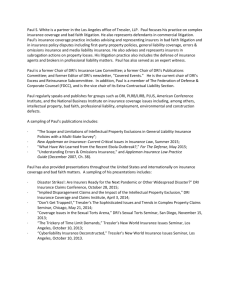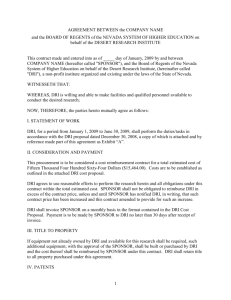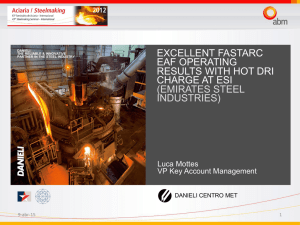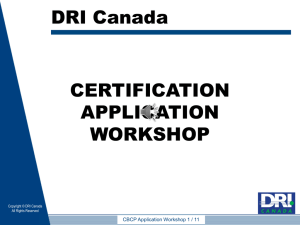Budget management - Swansea University
advertisement
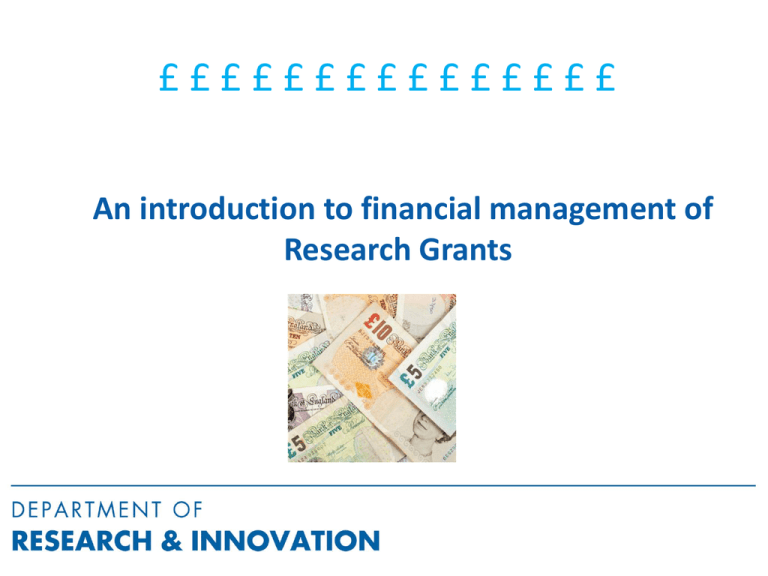
£££££££££££££££ An introduction to financial management of Research Grants • Overview of topics to be discussed:• • • • • • • • • Basic budget headings and terminology Using the University’s financial and administrative systems Brief guide to budget management Monitoring, budget planning and reporting Claims Audit Full Economic Costs and Overheads Match Funding Role of the DRI post award team • What is the aim of project financial management? • To fully utilise the project budget on appropriate (eligible) expenditure within a given timeframe • To maintain a comprehensive and auditable trail of financial records • Hence: • Project expenditure must be specific for the purposes defined in the contract • Project expenditure must be time limited • Project expenditure must be evidenced • You have the money…now what? • Typically, the budget is outlined in the award letter or financial annexe to a contract • You will manage the award via a financial code • A financial code will be issued by DRI and for a Research Project will be either a “R” or a “V” code (usually for commercial organisations with VAT considerations) • For example, ELR 250 or EGV 300 • DRI also issue codes for Consultancies, e.g. JPC 250 • The basic components of a budget and terminology • Direct costs, Indirect costs and Income • Direct costs: Usually Staff (N.I. and Superannuation included) and Non-staff • Typically, Staff budgets are split across Academic, Administrators, RA’s, Clerical and Technical Support • Staff often includes Studentships • Non-Staff; Equipment, Travel and Subsistence, Consumables, Office, Tuition Fees, Other costs • Indirect costs:- Overheads (fEC terms include directly allocated, Estates, Infrastructure Technicians and Other Indirect) • Grant income and other sources of income • Example • How does SU record the budget categories in the Financial system? • • • • SU uses the QL financial system The financial code consists of 3 main elements (3 levels) Lv1 Alpha Lv2 Numeric Lv3 Numeric or EGR 250 300 Alpha cost centre (describing School/College) e.g. EGR – Engineering Research • Numeric cost centre e.g. 250 • Numeric budget analysis (sub-code) e.g. 300 • Hence, EGR250 300; described as Academic salaries for Engineering Research project EGR250 • SU system for initiating payments of salary; Staff costs:• • • • • • • • PI or senior manager completes L6 request to HR Costs on L6 are approved by DRI (Sirius amount checked against budget) L6 formally approved Appointment process implemented by HR Salaries initiate payment on a monthly basis by charging financial code Charge will include NI and Superannuation (if applicable) Changes to staff costs usually take a lot of TIME – plan in advance! Transfers of Staff time from other SU School budgets are possible and create “slippage” on School salary budgets • SU system for initiating payments of non staff costs:• Purchases are typically processed via Purchase Order Processing by School /College administrative staff • Be aware of Financial Procedures and regulations in particular tendering thresholds. You need to allow plenty of time for significant value (>£25,000) purchases of goods and services • Budget management – accounting for the numbers • Use a clearly structured and logical system that can be accessed by others and is readily auditable Basic budget flowchart Establish budget Profile budget Monitor budget Examine variances and take action Audit may be planned or unannounced Timely reports to stakeholders • Budget management – general advice • Maintain a project file, award letter, Staff contracts, copies of claims. • Record the project financial information, e.g. spreadsheet • Plan the budget profile • Monitor the budget on a frequent basis (monthly or quarterly) • Ensure spend is eligible, complies with Sponsor T & C • Review the variances • Prepare a regular financial Report to highlight variances • Take corrective action where necessary (alert sponsor?) • Understand SU financial FP&P, tender thresholds etc (EU rules) • Budget management (general advice continued) • You may need to transfer budgets between major headings, i.e. Staff to Equipment. This is known as a “virement” • Rules of virement vary from sponsor to sponsor. Be aware of rules regarding transfer of budgets and seek authority of sponsor in writing where transfers are permissable • Be aware that a foreign currency carries possible burden of exchange rate differences • Be aware that income flow is on schedule, i.e. debt risk from a sponsor in financial difficulty • Budget management - Planning the time-line for expenditure • Typically, projects extend for several months and often years • It is vital to understand the budget “profile” over the project lifetime • It is good practice to define the profile at the outset • Profiling can be done in broad time periods but ideally over all major expenditure heads (example) • Facilitates a comparison between “where you are” against “where you want to be” • In the jargon, a “variance” of actual against target (budget) • Many sponsors require a report of actual spend against profile • Budget management - accounting for commitments • Ensure that you allow for future “known” expenditure, called “commitments” • Salary commitments can usually be calculated to contract enddate and are stated on the L6 application • Non-salary commitments are entered into the Purchase Order Processing System (POP) • Some items of expenditure are planned into the budget profile but be alert to pipeline expenditure that is not identified in any formal system – keep record on a budget spreadsheet • What can you expect to see on a SU financial report? • • • • • • • Example of QL ACP –Accounts payable, expenditure or cash-out PAY – a payment to staff CBK, SIV – Cash-in or income invoiced GEN – a journal transfer, often correcting errors or allocating expenditure to other codes List of sub-codes Monthly project report • Typical claims process • • • • • • • • Will be set by the grant terms and conditions from the sponsor Usually an invoice or specified grant claim form Frequency – usually quarterly (e.g. ESF ) , 6 monthly or annual May be governed by milestones or deliverables Claim will be prepared by DRI with PI’s input Based on actual spend on QL (and matched funding documentation for relevant grants e.g. ESF and Framework 7 Claim will need to be signed/dated and copies will be held by DRI and the PI Sponsor will make payments to SU based on the claim /invoice submitted • Overheads, fEC and closures • Typically, SU attempts to recover all overheads from the application of fEC (full Economic Cost) to the project budget • Be aware that such overheads are “returned” to the School and are not readily accessible to you the PI. You will manage the “direct elements” of the award via a financial code • You cannot spend against this “indirect” budget heading. Charges are processed automatically (usually monthly by DRI) and the income is transferred to the School business plan • Project under-spends (not otherwise returned to sponsor) are considered as “overheads” and although passed to an account (usually) ear-marked to the PI are regarded as School income • Typical audit requirements • Specified by the grant’s terms and conditions • Independent review of the claims made ( usually annual) • carried out by an external firm of accountants e.g. Price Waterhouse Coopers ( PWC ) for DTI or ERDF sponsored projects or sometimes by JIAU (Internal Audit ) • Will involve an audit visit and this will be co-ordinated by DRI • The auditors will check the claims thoroughly and will check back to original sources e.g Finance Dept for payslips or timesheets kept by the PI • Please take it seriously – it is a fact of life ! Potential payback • Preparation and planning is the key – DRI will help ! • Match Funding • • • • • • What is it ? Where will I come across it ? Why do I need to do it ? Resources put into the project by the University or others e.g. Existing staff time , Overheads , Donated equipment Audit trail – e.g. signed timesheets , hourly rates , University overhead calculation To date mainly on EC funded projects e.g. ESF,ERDF , Framework 7 Grants not paid at 100% so this allows us to cover our direct costs • Support from DRI and School • Usually there are up to 4 School administrators with access to QL (current financial information) • Each School has a dedicated member of staff in DRI who will be able to provide the most up-to-date information, support and guidance. Capacity limitations can affect level of service • Please try to give DRI reasonable notice • Major projects (>£500k) will typically involve DRI meeting with PI on a quarterly basis • You can find web advice and support here: http://www.swan.ac.uk/research_innovation • If you enjoyed financial management of your project…apply for more funding and do it all again! – Thank you for your time


